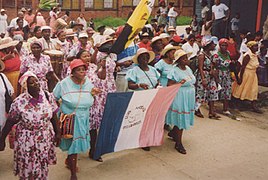Module 5: Middle America
Section outline
-

"Garifuna SanIsidro 1996" by Eve Demaziere is licensed under CC BY-SA 3.0
Middle America, the geographic realm between the United States and the continent of South America, consists of three main regions: the Caribbean, Mexico, and the Central American republics.
The Caribbean region, the most culturally diverse of the three, consists of more than seven thousand islands that stretch from the Bahamas to Barbados. The four largest islands of the Caribbean make up the Greater Antilles, which include Cuba, Jamaica, Hispaniola, and Puerto Rico. Hispaniola is split between Haiti in the west and the Dominican Republic in the east. The smaller islands, extending all the way to South America, make up the Lesser Antilles. The island that is farthest south is Trinidad, just off the coast of Venezuela. The Bahamas, the closest islands to the US mainland, are located in the Atlantic Ocean but are associated with the Caribbean region. The Caribbean region is surrounded by bodies of saltwater: the Caribbean Sea in the center, the Gulf of Mexico to the northwest, and the North Atlantic to the east.
Central America refers to the seven states south of Mexico: Belize, Guatemala, Honduras, El Salvador, Nicaragua, Costa Rica, and Panama. Panama borders the South American country of Colombia. During the colonial era, from 1492 to 1821, Panama was included in the part of South America controlled by the Spanish (it was considered part of the Viceroyalty of Peru). The Pacific Ocean borders Central America to the west, and the Caribbean Sea borders these countries to the east. While most of the republics have both a Caribbean and a Pacific coastline, Belize has only a Caribbean coast, and El Salvador has only a Pacific coast.
Garifuna San Isidro 1996-05, Eve Demaziare, , Creative Commons Attribution-Share Alike 2.5 Generic, 2.0 Generic and 1.0 Generic license.
Upon completion of this module, you will be able to:
, Creative Commons Attribution-Share Alike 2.5 Generic, 2.0 Generic and 1.0 Generic license.
Upon completion of this module, you will be able to:- Define the differences between the rimland and the mainland. (CO 1 & 4)
- Summarize the impact of European colonialism on Middle America. (CO 3, 4 & 5)
- Distinguish between the Mayan and Aztec Empires and identify which the Spanish defeated. (CO 1 & 4)
- Outline the socioeconomic classes in Mexico and explain the ethnic differences of each. (CLO 4)
- Describe how the physical environment has affected human activity in Central America and how the various republics differ from each other. (CLO 3, 4, 5, & 6)
- Outline the various ways in which the United States has affected the Caribbean and Central America, including the creation of NAFTA and the drug trade. (CLO 4, 5, & 6)
- Explain how tourism has become the main means of economic development for most of the Caribbean. (CLO 4, 5, & 6)
- Describe how and why hurricanes form and why they can be so dangerous. (CLO 3, 4, 5, & 6)
To achieve these objectives:
- Read the Module 5 Introduction.
- Read Chapter #5 - Introduction to the World in World Regional Geography: People, Places, and Globalization
- Complete the Module 5 Assignment, Discussion Board Posts (3), Chapter Quiz, and H5P activities.
Module Pressbooks Resources and Activities
You will find the following resources and activities in this module at the Pressbooks website. Click on the links below to access or complete each item. - Define the differences between the rimland and the mainland. (CO 1 & 4)
Background Colour
Font Face
Font Kerning
Font Size
Image Visibility
Letter Spacing
Line Height
Link Highlight
Text Colour
